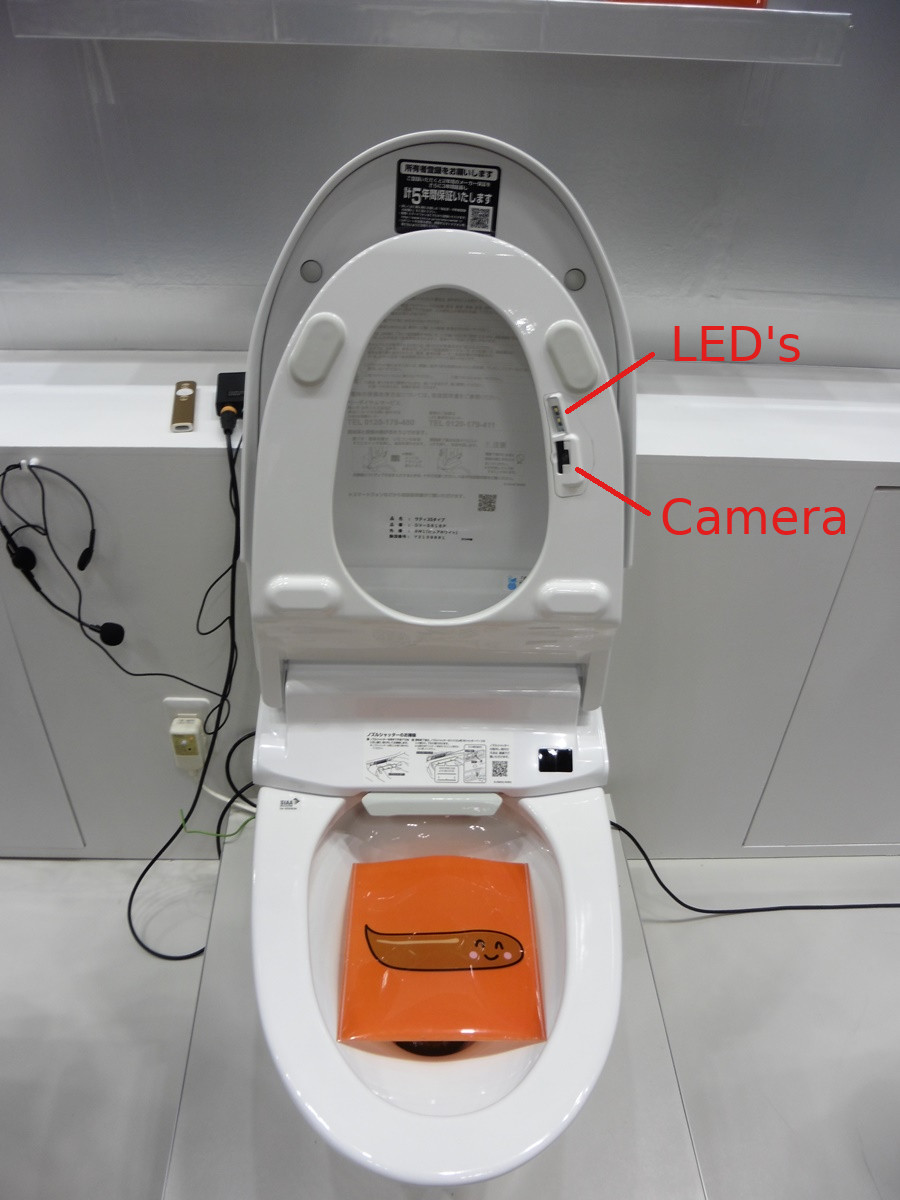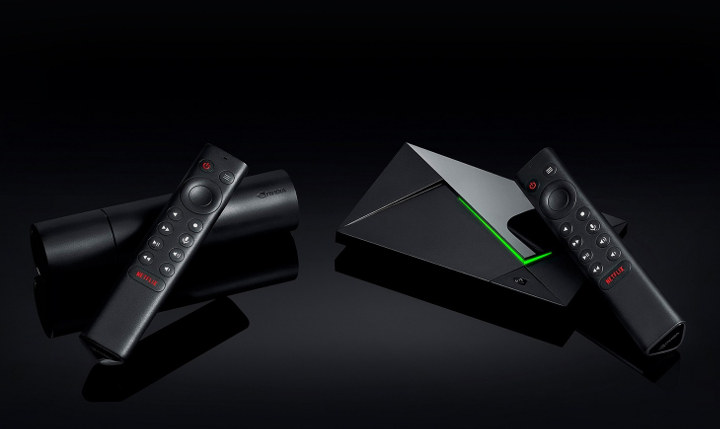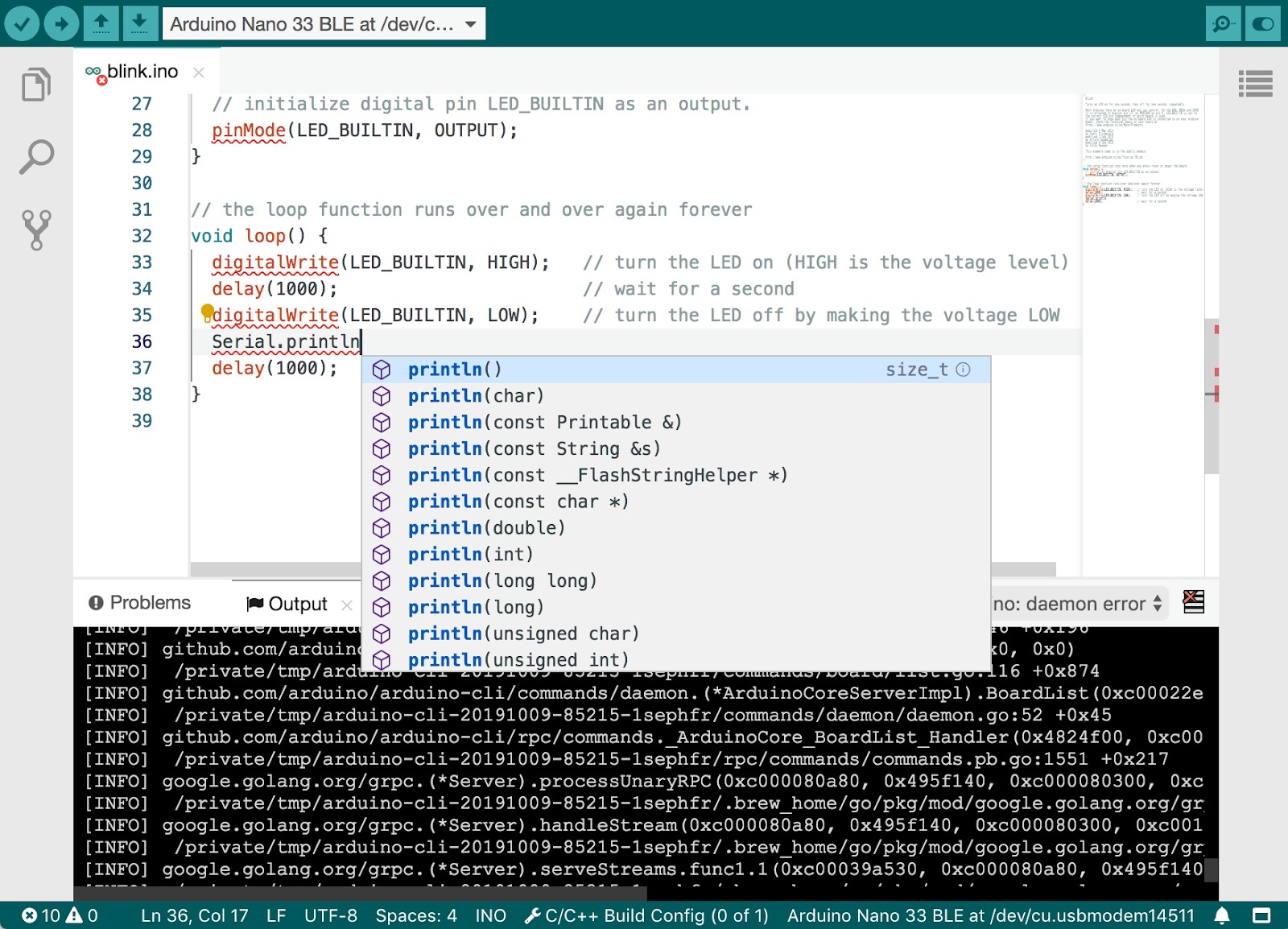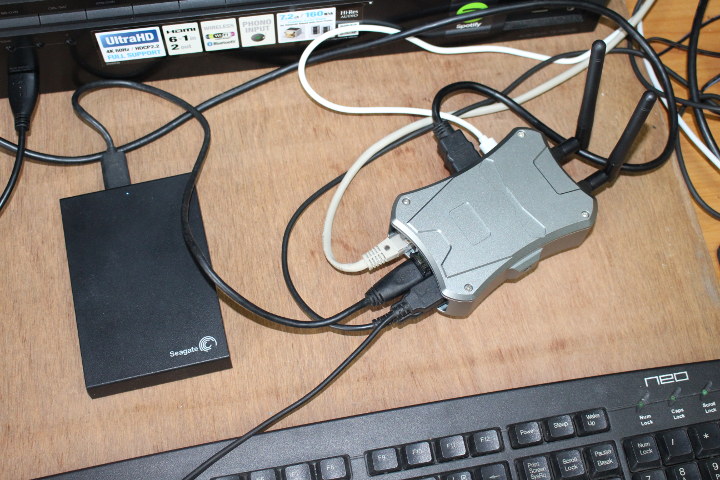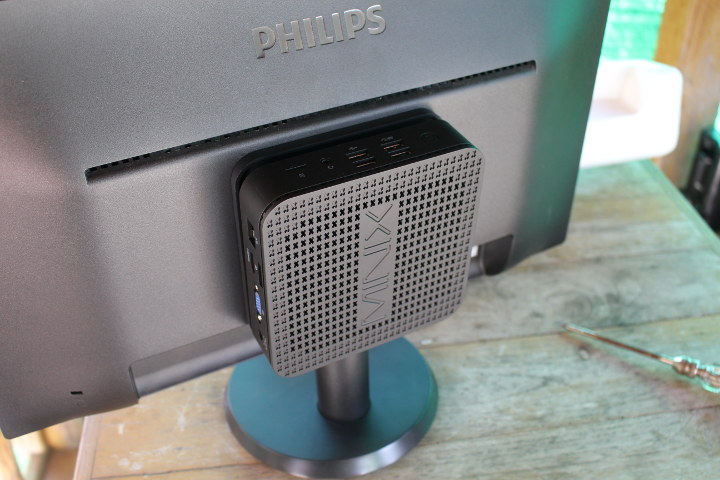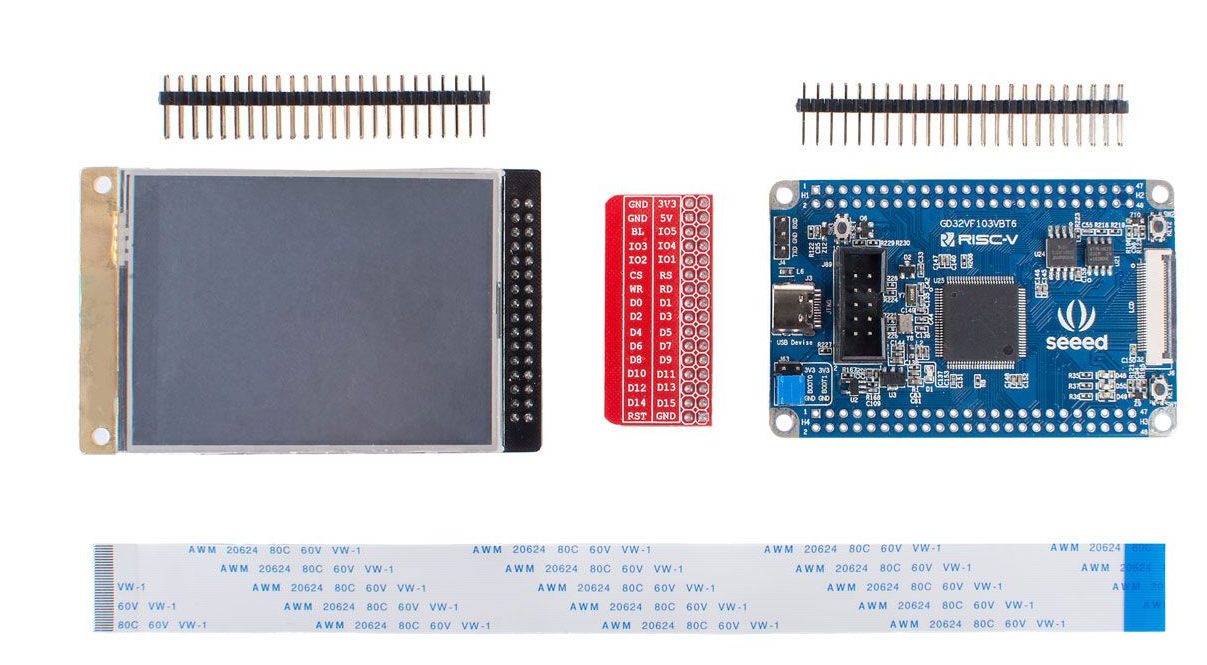You probably own a few battery-powered devices, maybe one or two phones, a camera, Bluetooth headset, etc…, and each requires a different cable. It’s also easy to forget bringing the right cable, and once your device runs out of battery you’re out of luck. inCharge 6 universal charging cable aims to solve this first world problem by offering a single cable that supports devices charged through USB Type-C, Lightning or Micro USB port, and small enough to hook to your keyring so you never forget it. Alternatively, the company also offers a 1.5-meter version of the cable. The cable takes power from USB type-A or type-C power supply, and output to USB type-C, Lightning or Micro USB with the latter two available through the same connector. The cable also allows you to charge a device from another device, and transfer data between the two (Charge & Sync) as illustrated below. […]
Lixil AI-based Toilet Analyzes Shape & Size of Feces with Camera and LEDs
Earlier this year, we wrote about machine learning & image processing in embedded systems using pasta type classification as an example. Lixil Group, a Japanese company manufacturing housing equipment, is working on a concept using similar technology, but instead of classifying pasta, they implemented the technology into an AI-based toilet that checks the shape and size of feces of people living in elderly facilities. Lixil’s toilet was unveiled at the 46th International Home Care & Rehabilitation Exhibition (HCR 2019) in Tokyo at the end of last month. The system relies on a camera and two LED’s placed on the back of the seat, which turn on when the user sits on the seat. Once the job is done, images of the feces are taken automatically and classified into seven categories as specified by the Bristol stool chart. Classification happens within a few seconds, and results can be check by staff […]
NVIDIA Launches Upgraded Shield TV with Tegra X1+ Processor
Ever since NVIDIA launched the Shield TV in 2015 it features in lists of best Android TV boxes in the $200 budget range, although it can raise to close to $300 if you do not live in a country where the Shield TV is not officially sold. The company launched a more compact version in 2017, and NVIDIA just officially announced upgraded Shield TV and Shield TV Pro 2019 models with a more powerful Tegra X1+ Processor delivering a 25% boost, as well as Dolby Atmos and Dolby Vision support. As you can see from the photo above the Shield TV now has a completely different cylindrical design, while the Shield TV Pro keeps the traditional design of the box. However, both share many of the same specifications: SoC – NVIDIA Tegra X1+ processor with a 256-core NVIDIA GPU Memory & Storage Shield: 2 GB RAM; 8GB eMMC flash; MicroSD card […]
The Arduino Pro IDE Targets Professional Developers
It is an underlying fact that Arduino changed or better still evolved the makers, electronics, DIY, open-source, or whatever ecosystem you can think of. It brought the power of creation to the average users irrespective of your current skill set or experiences. Engineers, Scientists, hobbyists, Professors, Makers, and others and have used the ecosystem Arduino has created to build and teach new things. Aside from the fantastic hardware that made all these possible, one of the significant contributors to this easy to use growing community is the IDE. The Arduino IDE is very simplified for newbies to use. Although the Arduino Classic IDE is a pretty decent IDE for building Arduino based projects, it doesn’t offer much for large scale projects or has the tools advance developers needs. I migrated to using Atmel Studio because of what the Arduino IDE was lacking, and others have considered using other IDEs like […]
NanoPi M4V2 Kit Review – Part 2: FriendlyCore Desktop
We’ve already seen how to assemble NanoPi M4V2 metal case kit which offers an Arm mini PC solution with support for NVMe SSD. The new NanoPi M4V2 Rockchip RK3399 SBC is an evolution of the M4 board that brings faster LPDDR4 memory and adds power & recovery buttons. Since we’ve already tested several RK3399 SBC‘s and TV boxes, I planned to focus the review on thermal design evaluation (i.e. see how well the board cools), and see how memory bandwidth evolved from LPDDR3 to LPDDR4. I wanted to do so both with Linux and Android, since I could compare NanoPC-T4 (LPDDR3) benchmarks in Android. But this requires an eMMC flash module, and I don’t own any. So instead I planned to run Armbian because of support for armbian-monitor for nice temperature chart but it’s not working just yet, so instead I’ve done all tests with FriendlyCore Desktop (rk3399-sd-friendlydesktop-bionic-4.4-arm64-20190926.img) based on […]
MINIX NEO G41V-4 Fanless Mini PC Review – Part 1: Unboxing & Teardown
MINIX showcased two new Gemini Lake mini PCs running Windows 10 Pro at IFA 2019 namely MINIX NEO J50C-4 (64GB) actively-cooled mini PC with an Intel Pentium Silver J5005 that’s basically a variant of last year’s NEO J50C-4 mini PC with more storage, as well as MINIX NEO G41V-4 fanless mini PC powered by an Intel Celeron N4100 processor. I’ve already reviewed the former mini PC with Windows 10 Pro, and the company has just sent me a sample of their just-released NEO G41V-4 mini PC which as we’ll see is a completely new design (internally). MINIX NEO G41V-4 Unboxing The mini PC did not come alone, as 240GB M.2 SATA SSD’s for NEO G41V-4 and NEO J50C-4 were also included. The specifications match what we initially reported with an Intel Celeron N4100 quad-core processor, 4GB DDR4, 64GB eMMC flash, and so on. The new enclosure has plenty of ventilation […]
Xebec Converts Your Laptop into a Triple Monitor Laptop (Crowdfunding)
Xebec a Triple Screen Device Add-on for Laptops Xebec has developed a two-screen addon for laptops ranging from 10″ to 20″ effectively expanding any laptop into a triple monitor laptop. The idea of extending a laptop screen is not new. Mobile Pixels had developed an attachable extension screen called the DUO and we reported on it in a previous article. Xebec is a Sailing Ship A Xebec is a small three sail ship, with square sails, a very apropos term for this system of three small square screens. Go Anywhere With Triple the Screens The aim is to be able to attach the screens on-the-go and have them work as well as a full monitor. Xebec’s two-screen extension attaches to the back of any monitor screen. The pair of displays slide left and right so their screens are completely viewable. The System Is Lightweight The unit weighs 1.9 lbs […]
Another GD32 RISC-V Development Kit with LCD By Seeed Studio
Recently we highlighted the $5 Longan Nano, a development kit released by Sipeed for the Gigadevice GD32V RISC-V family of microcontrollers. The Sipeed Longan Nano is powered by the GigaDevice’s GD32VF103CBT6, based on Nucleisys Bumblebee kernel (support RV32IMAC instruction sets and ECLIC rapid interrupt). Seeed Studio is currently on this quest for expanding the Gigadevice GD32V RISC-V ecosystem with the launch of the SeeedStudio GD32 RISC-V kit with LCD. The Seeed Studio development kit is based on the SeeedStudio GD32 RISC-V Dev Board and a 2.8 inch 240×320 pixel resistive LCD screen. The Seeed Studio GD32 RISC-V Dev Board is based on the 32-bit general-purpose GD32VF103VBT6 MCU, which can run at up to 108MHz. It comes with a 128KB on-chip Flash memory, and a 32KB SRAM memory. The development board comes with a total of 80 GPIOs, an onboard 8MB Flash and 256 Byte EEPROM, a staggering amount resources for this […]



